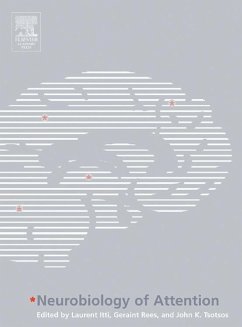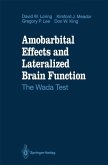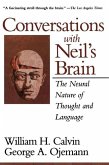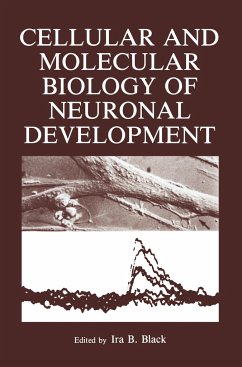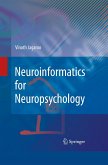Laurent Itti / Geraint Rees / John K. Tsotsos (eds.)
Neurobiology of Attention
Herausgeber: Itti, Laurent; Tsotsos, John K; Rees, Geraint
Laurent Itti / Geraint Rees / John K. Tsotsos (eds.)
Neurobiology of Attention
Herausgeber: Itti, Laurent; Tsotsos, John K; Rees, Geraint
- Gebundenes Buch
- Merkliste
- Auf die Merkliste
- Bewerten Bewerten
- Teilen
- Produkt teilen
- Produkterinnerung
- Produkterinnerung
Attention research has experienced rapid growth over the past two decades, as new experimental techniques and modeling tools have become available to study higher brain function in humans, non-human primates, and other mammals. While there are a number of books covering specific attention-related subjects, currently no one comprehensive reference exists on the subject. This book aims to become the definitive reference handbook on the neurobiology of attention. It provides numerous short articles specifically focused on one detailed area, with "roadmap" commentaries integrating the articles by…mehr
Andere Kunden interessierten sich auch für
![Handbook of Stress and the Brain Part 1: The Neurobiology of Stress Handbook of Stress and the Brain Part 1: The Neurobiology of Stress]() Thomas StecklerHandbook of Stress and the Brain Part 1: The Neurobiology of Stress333,99 €
Thomas StecklerHandbook of Stress and the Brain Part 1: The Neurobiology of Stress333,99 €![Amobarbital Effects and Lateralized Brain Function Amobarbital Effects and Lateralized Brain Function]() David W. LoringAmobarbital Effects and Lateralized Brain Function48,99 €
David W. LoringAmobarbital Effects and Lateralized Brain Function48,99 €![Conversations with Neil's Brain Conversations with Neil's Brain]() William H CalvinConversations with Neil's Brain21,99 €
William H CalvinConversations with Neil's Brain21,99 €![Cognitive-Behavioral Therapy for Bipolar Disorder Cognitive-Behavioral Therapy for Bipolar Disorder]() Monica Ramirez BascoCognitive-Behavioral Therapy for Bipolar Disorder108,99 €
Monica Ramirez BascoCognitive-Behavioral Therapy for Bipolar Disorder108,99 €![Cellular and Molecular Biology of Neuronal Development Cellular and Molecular Biology of Neuronal Development]() Ira BlackCellular and Molecular Biology of Neuronal Development42,99 €
Ira BlackCellular and Molecular Biology of Neuronal Development42,99 €![Neuroinformatics for Neuropsychology Neuroinformatics for Neuropsychology]() Vinoth JagarooNeuroinformatics for Neuropsychology74,99 €
Vinoth JagarooNeuroinformatics for Neuropsychology74,99 €![Cingulate Cortex Cingulate Cortex]() Cingulate Cortex297,99 €
Cingulate Cortex297,99 €-
-
-
Attention research has experienced rapid growth over the past two decades, as new experimental techniques and modeling tools have become available to study higher brain function in humans, non-human primates, and other mammals. While there are a number of books covering specific attention-related subjects, currently no one comprehensive reference exists on the subject. This book aims to become the definitive reference handbook on the neurobiology of attention. It provides numerous short articles specifically focused on one detailed area, with "roadmap" commentaries integrating the articles by identifying themes and inter-relationships among them. The articles will include both introductory and review material, ideal for students and cross-disciplinary study, as well as the most recent research results appealing to specialists in the field.
Hinweis: Dieser Artikel kann nur an eine deutsche Lieferadresse ausgeliefert werden.
Hinweis: Dieser Artikel kann nur an eine deutsche Lieferadresse ausgeliefert werden.
Produktdetails
- Produktdetails
- Verlag: Elsevier Science
- Seitenzahl: 744
- Erscheinungstermin: 9. März 2005
- Englisch
- Abmessung: 286mm x 223mm x 42mm
- Gewicht: 2316g
- ISBN-13: 9780123757319
- ISBN-10: 0123757312
- Artikelnr.: 20964208
- Herstellerkennzeichnung
- Libri GmbH
- Europaallee 1
- 36244 Bad Hersfeld
- 06621 890
- Verlag: Elsevier Science
- Seitenzahl: 744
- Erscheinungstermin: 9. März 2005
- Englisch
- Abmessung: 286mm x 223mm x 42mm
- Gewicht: 2316g
- ISBN-13: 9780123757319
- ISBN-10: 0123757312
- Artikelnr.: 20964208
- Herstellerkennzeichnung
- Libri GmbH
- Europaallee 1
- 36244 Bad Hersfeld
- 06621 890
I: FOUNDATIONS
Chapter 1: Computational Foundations for Attentive Processes
Chapter 2: Capacity Limits for Spatial Discrimination
Chapter 3: Directed Visual Attention and the Dynamic Control of Information
Flow
Chapter 4: Selective Attention as an Optimal Computational Strategy
Chapter 5: Surprise: A Shortcut for Attention?
Chapter 6: A Heteromodal Large-Scale Network for Spatial Attention
Chapter 7: Parietal Mechanisms of Attentional Control: Locations, Features,
and Objects
Chapter 8: Visual Cortical Circuits and Spatial Attention
Chapter 9: Psychopharmacology of Human Attention
Chapter 10: Neuropharmacology of Attention
Chapter 11: Identifying the Neural Systems of Top-Down Attentional Control:
A Meta-analytic Approach
Chapter 12: Attention Capture: The Interplay of Expectations, Attention,
and Awareness
Chapter 13: Change Blindness
Chapter 14: Development of Covert Orienting in Young Infants
Chapter 15: Prior Entry
Chapter 16: Inhibition of Return
Chapter 17: Guidance of Visual Search by Preattentive Information
Chapter 18: The Top in Top-Down Attention
Chapter 19: Allocation of Attention in Three-Dimensional Space
Chapter 20: Covert Attention and Saccadic Eye Movements
Chapter 21: Prefrontal Selection and Control of Covert and Overt Orienting
Chapter 22: Dissociation of Selection from Saccade Programming
Chapter 23: Space- and Object-Based Attention
Chapter 24: Attention and Binding
Chapter 25: Top-Down Facilitation of Visual Object Recognition
Chapter 26: Spatial Processing of Environmental Representations
Chapter 27: Decision and Attention
Chapter 28: Visual Attention and Emotional Perception
Chapter 29: The Difference between Visual Attention and Awareness: A
Cognitive Neuroscience Perspective
Chapter 30: Reaching Affects Saccade Trajectories
Chapter 31: The Premotor Theory of Attention
Chapter 32: Cross-Modal Consequences of Human Spatial Attention
Chapter 33: Attention and Scene Understanding
II: FUNCTIONS
Chapter 34: Visual Search and Popout in Infancy
Chapter 35: Attention in Conditioning
Chapter 36: Electrophysiology of Reflexive Attention
Chapter 37: Natural Scene Statistics and Salient Visual Features
Chapter 38: Salience of Feature Contrast
Chapter 39: Stimulus-Driven Guidance of Visual Attention in Natural Scenes
Chapter 40: Contextual Guidance of Visual Attention
Chapter 41: Gist of the Scene
Chapter 42: Temporal Orienting of Attention
Chapter 43: Visual Search: The Role of Memory for Rejected Distractors
Chapter 44: The Neuropsychology of Visual Feature Binding
Chapter 45: Visual Saliency and Spike Timing in the Ventral Visual Pathway
Chapter 46: Object Recognition in Cortex: Neural Mechanisms, and Possible
Roles for Attention
Chapter 47: Binding Contour Segments into Spatially Extended Objects
Chapter 48: Scanpath Theory, Attention, and Image Processing Algorithms for
Predicting Human Eye Fixations
Chapter 49: The Feature Similarity Gain Model of Attention: Unifying
Multiplicative Effects of Spatial and Feature-based Attention
Chapter 50: Biasing Competition in Human Visual Cortex
Chapter 51: Nonsensory Signals in Early Visual Cortex
Chapter 52: Effects of Attention on Auditory Perceptual Organization
Chapter 53: Attention in Language
Chapter 54: Attention and Spatial Language
Chapter 55: The Sustained Attention to Response Test (SART)
Chapter 56: ERP Measures of Multiple Attention Deficits Following
Prefrontal Damage
Chapter 57: Nonspatially Lateralized Mechanisms in Hemispatial Neglect
Chapter 58: Visual Extinction and Hemispatial Neglect after Brain Damage:
Neurophysiological Basis of Residual Processing
Chapter 59: Attention in Split-Brain Patients
Chapter 60: Divided Attention in the Normal and the Split Brain:
Chronometry and Imaging
III: MECHANISMS
Chapter 61: Neurophysiological Correlates of the Attentional Spotlight
Chapter 62: Spatially-Specific Attentional Modulation Revealed by fMRI
Chapter 63: The Neural Basis of the Attentional Blink
Chapter 64: Neurophysiological Correlates of the Reflexive Orienting of
Spatial Attention
Chapter 65: Specifying the Components of Attention in a Visual Search Task
Chapter 66: Neural Evidence for Object-based Attention
Chapter 67: Location- or Feature-based Targeting of Spatial Attention
Chapter 68: Dimension-based Attention in Pop-out Search
Chapter 69: Irrelevant Singletons Capture Attention
Chapter 70: Attentional Modulation of Apparent Stimulus Contrast
Chapter 71: Attentional Suppression Early in the Macaque Visual System
Chapter 72: Attentional Modulation in the Human Lateral Geniculate Nucleus
and Pulvinar
Chapter 73: Transient Covert Attention Increases Contrast Sensitivity and
Spatial Resolution: Support for Signal Enhancement
Chapter 74: External Noise Distinguishes Mechanisms of Attention
Chapter 75: Attentional Modulation and Changes in Effective Connectivity
Chapter 76: Attentional Modulation of Surround Inhibition
Chapter 77: Attentional Processes in Texture Perception
Chapter 78: Mechanisms of Perceptual Learning
Chapter 79: Lateral Interactions between Targets and Flankers Require
Attention
Chapter 80: Attention and Changes in Neural Selectivity
Chapter 81: Attentional Effects on Motion Processing
Chapter 82: ERP Studies of Selective Attention to Nonspatial Features
Chapter 83: Effects of Attention on Figure-Ground Responses in the Primary
Visual Cortex during Working Memory
Chapter 84: Electrophysiological and Neuroimaging Approaches to the Study
of Visual Attention
Chapter 85: The Timing of Attentional Modulation of Visual Processing as
Indexed by ERPs
Chapter 86: Selective Visual Attention Modulates Oscillatory Neuronal
Synchronization
Chapter 87: Putative Role of Oscillations and Synchrony in Cortical Signal
Processing and Attention
Chapter 88: Attention to Tactile Stimuli Increases Neural Synchrony in
Somatosensory Cortex
Chapter 89: Crossmodal Attention in Event Perception
IV: SYSTEMS
Chapter 90: The FeatureGate Model of Visual Selection
Chapter 91: Probabilistic Models of Attention Based on Iconic
Representations and Predictive Coding
Chapter 92: The Selective Tuning Model for Visual Attention
Chapter 93: The Primary Visual Cortex Creates a Bottom-up Saliency Map
Chapter 94: Models of Bottom-up Attention and Saliency
Chapter 95: Saliency in Computer Vision
Chapter 96: Contextual Influences on Saliency
Chapter 97: A Neurodynamical Model of Visual Attention
Chapter 98: How the Detection of Objects in Natural Scenes Constrains
Attention in Time
Chapter 99: Memory-Driven Visual Attention: An Emergent Behavior of
Map-Seeking Circuits
Chapter 100: The Role of Short-Term Memory in Visual Attention
Chapter 101: Scene Segmentation through Synchronization
Chapter 102: Attentive Wide-Field Sensing for Visual Telepresence and
Surveillance
Chapter 103: Neuromorphic Selective Attention Systems
Chapter 104: The Role of Visual Attention in the Control of Locomotion
Chapter 105: Attention Architectures for Machine Vision and Mobile Robots
Chapter 106: Attention for Computer Graphics Rendering
Chapter 107: Linking Attention to Learning, Expectation, Competition, and
Consciousness
Chapter 108: Attention-Guided Recognition Based on "What? and "Where?:
Representations: A Behavioral Model
Chapter 109: A Model of Attention and Recognition by Information
Maximization
Index
Chapter 1: Computational Foundations for Attentive Processes
Chapter 2: Capacity Limits for Spatial Discrimination
Chapter 3: Directed Visual Attention and the Dynamic Control of Information
Flow
Chapter 4: Selective Attention as an Optimal Computational Strategy
Chapter 5: Surprise: A Shortcut for Attention?
Chapter 6: A Heteromodal Large-Scale Network for Spatial Attention
Chapter 7: Parietal Mechanisms of Attentional Control: Locations, Features,
and Objects
Chapter 8: Visual Cortical Circuits and Spatial Attention
Chapter 9: Psychopharmacology of Human Attention
Chapter 10: Neuropharmacology of Attention
Chapter 11: Identifying the Neural Systems of Top-Down Attentional Control:
A Meta-analytic Approach
Chapter 12: Attention Capture: The Interplay of Expectations, Attention,
and Awareness
Chapter 13: Change Blindness
Chapter 14: Development of Covert Orienting in Young Infants
Chapter 15: Prior Entry
Chapter 16: Inhibition of Return
Chapter 17: Guidance of Visual Search by Preattentive Information
Chapter 18: The Top in Top-Down Attention
Chapter 19: Allocation of Attention in Three-Dimensional Space
Chapter 20: Covert Attention and Saccadic Eye Movements
Chapter 21: Prefrontal Selection and Control of Covert and Overt Orienting
Chapter 22: Dissociation of Selection from Saccade Programming
Chapter 23: Space- and Object-Based Attention
Chapter 24: Attention and Binding
Chapter 25: Top-Down Facilitation of Visual Object Recognition
Chapter 26: Spatial Processing of Environmental Representations
Chapter 27: Decision and Attention
Chapter 28: Visual Attention and Emotional Perception
Chapter 29: The Difference between Visual Attention and Awareness: A
Cognitive Neuroscience Perspective
Chapter 30: Reaching Affects Saccade Trajectories
Chapter 31: The Premotor Theory of Attention
Chapter 32: Cross-Modal Consequences of Human Spatial Attention
Chapter 33: Attention and Scene Understanding
II: FUNCTIONS
Chapter 34: Visual Search and Popout in Infancy
Chapter 35: Attention in Conditioning
Chapter 36: Electrophysiology of Reflexive Attention
Chapter 37: Natural Scene Statistics and Salient Visual Features
Chapter 38: Salience of Feature Contrast
Chapter 39: Stimulus-Driven Guidance of Visual Attention in Natural Scenes
Chapter 40: Contextual Guidance of Visual Attention
Chapter 41: Gist of the Scene
Chapter 42: Temporal Orienting of Attention
Chapter 43: Visual Search: The Role of Memory for Rejected Distractors
Chapter 44: The Neuropsychology of Visual Feature Binding
Chapter 45: Visual Saliency and Spike Timing in the Ventral Visual Pathway
Chapter 46: Object Recognition in Cortex: Neural Mechanisms, and Possible
Roles for Attention
Chapter 47: Binding Contour Segments into Spatially Extended Objects
Chapter 48: Scanpath Theory, Attention, and Image Processing Algorithms for
Predicting Human Eye Fixations
Chapter 49: The Feature Similarity Gain Model of Attention: Unifying
Multiplicative Effects of Spatial and Feature-based Attention
Chapter 50: Biasing Competition in Human Visual Cortex
Chapter 51: Nonsensory Signals in Early Visual Cortex
Chapter 52: Effects of Attention on Auditory Perceptual Organization
Chapter 53: Attention in Language
Chapter 54: Attention and Spatial Language
Chapter 55: The Sustained Attention to Response Test (SART)
Chapter 56: ERP Measures of Multiple Attention Deficits Following
Prefrontal Damage
Chapter 57: Nonspatially Lateralized Mechanisms in Hemispatial Neglect
Chapter 58: Visual Extinction and Hemispatial Neglect after Brain Damage:
Neurophysiological Basis of Residual Processing
Chapter 59: Attention in Split-Brain Patients
Chapter 60: Divided Attention in the Normal and the Split Brain:
Chronometry and Imaging
III: MECHANISMS
Chapter 61: Neurophysiological Correlates of the Attentional Spotlight
Chapter 62: Spatially-Specific Attentional Modulation Revealed by fMRI
Chapter 63: The Neural Basis of the Attentional Blink
Chapter 64: Neurophysiological Correlates of the Reflexive Orienting of
Spatial Attention
Chapter 65: Specifying the Components of Attention in a Visual Search Task
Chapter 66: Neural Evidence for Object-based Attention
Chapter 67: Location- or Feature-based Targeting of Spatial Attention
Chapter 68: Dimension-based Attention in Pop-out Search
Chapter 69: Irrelevant Singletons Capture Attention
Chapter 70: Attentional Modulation of Apparent Stimulus Contrast
Chapter 71: Attentional Suppression Early in the Macaque Visual System
Chapter 72: Attentional Modulation in the Human Lateral Geniculate Nucleus
and Pulvinar
Chapter 73: Transient Covert Attention Increases Contrast Sensitivity and
Spatial Resolution: Support for Signal Enhancement
Chapter 74: External Noise Distinguishes Mechanisms of Attention
Chapter 75: Attentional Modulation and Changes in Effective Connectivity
Chapter 76: Attentional Modulation of Surround Inhibition
Chapter 77: Attentional Processes in Texture Perception
Chapter 78: Mechanisms of Perceptual Learning
Chapter 79: Lateral Interactions between Targets and Flankers Require
Attention
Chapter 80: Attention and Changes in Neural Selectivity
Chapter 81: Attentional Effects on Motion Processing
Chapter 82: ERP Studies of Selective Attention to Nonspatial Features
Chapter 83: Effects of Attention on Figure-Ground Responses in the Primary
Visual Cortex during Working Memory
Chapter 84: Electrophysiological and Neuroimaging Approaches to the Study
of Visual Attention
Chapter 85: The Timing of Attentional Modulation of Visual Processing as
Indexed by ERPs
Chapter 86: Selective Visual Attention Modulates Oscillatory Neuronal
Synchronization
Chapter 87: Putative Role of Oscillations and Synchrony in Cortical Signal
Processing and Attention
Chapter 88: Attention to Tactile Stimuli Increases Neural Synchrony in
Somatosensory Cortex
Chapter 89: Crossmodal Attention in Event Perception
IV: SYSTEMS
Chapter 90: The FeatureGate Model of Visual Selection
Chapter 91: Probabilistic Models of Attention Based on Iconic
Representations and Predictive Coding
Chapter 92: The Selective Tuning Model for Visual Attention
Chapter 93: The Primary Visual Cortex Creates a Bottom-up Saliency Map
Chapter 94: Models of Bottom-up Attention and Saliency
Chapter 95: Saliency in Computer Vision
Chapter 96: Contextual Influences on Saliency
Chapter 97: A Neurodynamical Model of Visual Attention
Chapter 98: How the Detection of Objects in Natural Scenes Constrains
Attention in Time
Chapter 99: Memory-Driven Visual Attention: An Emergent Behavior of
Map-Seeking Circuits
Chapter 100: The Role of Short-Term Memory in Visual Attention
Chapter 101: Scene Segmentation through Synchronization
Chapter 102: Attentive Wide-Field Sensing for Visual Telepresence and
Surveillance
Chapter 103: Neuromorphic Selective Attention Systems
Chapter 104: The Role of Visual Attention in the Control of Locomotion
Chapter 105: Attention Architectures for Machine Vision and Mobile Robots
Chapter 106: Attention for Computer Graphics Rendering
Chapter 107: Linking Attention to Learning, Expectation, Competition, and
Consciousness
Chapter 108: Attention-Guided Recognition Based on "What? and "Where?:
Representations: A Behavioral Model
Chapter 109: A Model of Attention and Recognition by Information
Maximization
Index
I: FOUNDATIONS
Chapter 1: Computational Foundations for Attentive Processes
Chapter 2: Capacity Limits for Spatial Discrimination
Chapter 3: Directed Visual Attention and the Dynamic Control of Information
Flow
Chapter 4: Selective Attention as an Optimal Computational Strategy
Chapter 5: Surprise: A Shortcut for Attention?
Chapter 6: A Heteromodal Large-Scale Network for Spatial Attention
Chapter 7: Parietal Mechanisms of Attentional Control: Locations, Features,
and Objects
Chapter 8: Visual Cortical Circuits and Spatial Attention
Chapter 9: Psychopharmacology of Human Attention
Chapter 10: Neuropharmacology of Attention
Chapter 11: Identifying the Neural Systems of Top-Down Attentional Control:
A Meta-analytic Approach
Chapter 12: Attention Capture: The Interplay of Expectations, Attention,
and Awareness
Chapter 13: Change Blindness
Chapter 14: Development of Covert Orienting in Young Infants
Chapter 15: Prior Entry
Chapter 16: Inhibition of Return
Chapter 17: Guidance of Visual Search by Preattentive Information
Chapter 18: The Top in Top-Down Attention
Chapter 19: Allocation of Attention in Three-Dimensional Space
Chapter 20: Covert Attention and Saccadic Eye Movements
Chapter 21: Prefrontal Selection and Control of Covert and Overt Orienting
Chapter 22: Dissociation of Selection from Saccade Programming
Chapter 23: Space- and Object-Based Attention
Chapter 24: Attention and Binding
Chapter 25: Top-Down Facilitation of Visual Object Recognition
Chapter 26: Spatial Processing of Environmental Representations
Chapter 27: Decision and Attention
Chapter 28: Visual Attention and Emotional Perception
Chapter 29: The Difference between Visual Attention and Awareness: A
Cognitive Neuroscience Perspective
Chapter 30: Reaching Affects Saccade Trajectories
Chapter 31: The Premotor Theory of Attention
Chapter 32: Cross-Modal Consequences of Human Spatial Attention
Chapter 33: Attention and Scene Understanding
II: FUNCTIONS
Chapter 34: Visual Search and Popout in Infancy
Chapter 35: Attention in Conditioning
Chapter 36: Electrophysiology of Reflexive Attention
Chapter 37: Natural Scene Statistics and Salient Visual Features
Chapter 38: Salience of Feature Contrast
Chapter 39: Stimulus-Driven Guidance of Visual Attention in Natural Scenes
Chapter 40: Contextual Guidance of Visual Attention
Chapter 41: Gist of the Scene
Chapter 42: Temporal Orienting of Attention
Chapter 43: Visual Search: The Role of Memory for Rejected Distractors
Chapter 44: The Neuropsychology of Visual Feature Binding
Chapter 45: Visual Saliency and Spike Timing in the Ventral Visual Pathway
Chapter 46: Object Recognition in Cortex: Neural Mechanisms, and Possible
Roles for Attention
Chapter 47: Binding Contour Segments into Spatially Extended Objects
Chapter 48: Scanpath Theory, Attention, and Image Processing Algorithms for
Predicting Human Eye Fixations
Chapter 49: The Feature Similarity Gain Model of Attention: Unifying
Multiplicative Effects of Spatial and Feature-based Attention
Chapter 50: Biasing Competition in Human Visual Cortex
Chapter 51: Nonsensory Signals in Early Visual Cortex
Chapter 52: Effects of Attention on Auditory Perceptual Organization
Chapter 53: Attention in Language
Chapter 54: Attention and Spatial Language
Chapter 55: The Sustained Attention to Response Test (SART)
Chapter 56: ERP Measures of Multiple Attention Deficits Following
Prefrontal Damage
Chapter 57: Nonspatially Lateralized Mechanisms in Hemispatial Neglect
Chapter 58: Visual Extinction and Hemispatial Neglect after Brain Damage:
Neurophysiological Basis of Residual Processing
Chapter 59: Attention in Split-Brain Patients
Chapter 60: Divided Attention in the Normal and the Split Brain:
Chronometry and Imaging
III: MECHANISMS
Chapter 61: Neurophysiological Correlates of the Attentional Spotlight
Chapter 62: Spatially-Specific Attentional Modulation Revealed by fMRI
Chapter 63: The Neural Basis of the Attentional Blink
Chapter 64: Neurophysiological Correlates of the Reflexive Orienting of
Spatial Attention
Chapter 65: Specifying the Components of Attention in a Visual Search Task
Chapter 66: Neural Evidence for Object-based Attention
Chapter 67: Location- or Feature-based Targeting of Spatial Attention
Chapter 68: Dimension-based Attention in Pop-out Search
Chapter 69: Irrelevant Singletons Capture Attention
Chapter 70: Attentional Modulation of Apparent Stimulus Contrast
Chapter 71: Attentional Suppression Early in the Macaque Visual System
Chapter 72: Attentional Modulation in the Human Lateral Geniculate Nucleus
and Pulvinar
Chapter 73: Transient Covert Attention Increases Contrast Sensitivity and
Spatial Resolution: Support for Signal Enhancement
Chapter 74: External Noise Distinguishes Mechanisms of Attention
Chapter 75: Attentional Modulation and Changes in Effective Connectivity
Chapter 76: Attentional Modulation of Surround Inhibition
Chapter 77: Attentional Processes in Texture Perception
Chapter 78: Mechanisms of Perceptual Learning
Chapter 79: Lateral Interactions between Targets and Flankers Require
Attention
Chapter 80: Attention and Changes in Neural Selectivity
Chapter 81: Attentional Effects on Motion Processing
Chapter 82: ERP Studies of Selective Attention to Nonspatial Features
Chapter 83: Effects of Attention on Figure-Ground Responses in the Primary
Visual Cortex during Working Memory
Chapter 84: Electrophysiological and Neuroimaging Approaches to the Study
of Visual Attention
Chapter 85: The Timing of Attentional Modulation of Visual Processing as
Indexed by ERPs
Chapter 86: Selective Visual Attention Modulates Oscillatory Neuronal
Synchronization
Chapter 87: Putative Role of Oscillations and Synchrony in Cortical Signal
Processing and Attention
Chapter 88: Attention to Tactile Stimuli Increases Neural Synchrony in
Somatosensory Cortex
Chapter 89: Crossmodal Attention in Event Perception
IV: SYSTEMS
Chapter 90: The FeatureGate Model of Visual Selection
Chapter 91: Probabilistic Models of Attention Based on Iconic
Representations and Predictive Coding
Chapter 92: The Selective Tuning Model for Visual Attention
Chapter 93: The Primary Visual Cortex Creates a Bottom-up Saliency Map
Chapter 94: Models of Bottom-up Attention and Saliency
Chapter 95: Saliency in Computer Vision
Chapter 96: Contextual Influences on Saliency
Chapter 97: A Neurodynamical Model of Visual Attention
Chapter 98: How the Detection of Objects in Natural Scenes Constrains
Attention in Time
Chapter 99: Memory-Driven Visual Attention: An Emergent Behavior of
Map-Seeking Circuits
Chapter 100: The Role of Short-Term Memory in Visual Attention
Chapter 101: Scene Segmentation through Synchronization
Chapter 102: Attentive Wide-Field Sensing for Visual Telepresence and
Surveillance
Chapter 103: Neuromorphic Selective Attention Systems
Chapter 104: The Role of Visual Attention in the Control of Locomotion
Chapter 105: Attention Architectures for Machine Vision and Mobile Robots
Chapter 106: Attention for Computer Graphics Rendering
Chapter 107: Linking Attention to Learning, Expectation, Competition, and
Consciousness
Chapter 108: Attention-Guided Recognition Based on "What? and "Where?:
Representations: A Behavioral Model
Chapter 109: A Model of Attention and Recognition by Information
Maximization
Index
Chapter 1: Computational Foundations for Attentive Processes
Chapter 2: Capacity Limits for Spatial Discrimination
Chapter 3: Directed Visual Attention and the Dynamic Control of Information
Flow
Chapter 4: Selective Attention as an Optimal Computational Strategy
Chapter 5: Surprise: A Shortcut for Attention?
Chapter 6: A Heteromodal Large-Scale Network for Spatial Attention
Chapter 7: Parietal Mechanisms of Attentional Control: Locations, Features,
and Objects
Chapter 8: Visual Cortical Circuits and Spatial Attention
Chapter 9: Psychopharmacology of Human Attention
Chapter 10: Neuropharmacology of Attention
Chapter 11: Identifying the Neural Systems of Top-Down Attentional Control:
A Meta-analytic Approach
Chapter 12: Attention Capture: The Interplay of Expectations, Attention,
and Awareness
Chapter 13: Change Blindness
Chapter 14: Development of Covert Orienting in Young Infants
Chapter 15: Prior Entry
Chapter 16: Inhibition of Return
Chapter 17: Guidance of Visual Search by Preattentive Information
Chapter 18: The Top in Top-Down Attention
Chapter 19: Allocation of Attention in Three-Dimensional Space
Chapter 20: Covert Attention and Saccadic Eye Movements
Chapter 21: Prefrontal Selection and Control of Covert and Overt Orienting
Chapter 22: Dissociation of Selection from Saccade Programming
Chapter 23: Space- and Object-Based Attention
Chapter 24: Attention and Binding
Chapter 25: Top-Down Facilitation of Visual Object Recognition
Chapter 26: Spatial Processing of Environmental Representations
Chapter 27: Decision and Attention
Chapter 28: Visual Attention and Emotional Perception
Chapter 29: The Difference between Visual Attention and Awareness: A
Cognitive Neuroscience Perspective
Chapter 30: Reaching Affects Saccade Trajectories
Chapter 31: The Premotor Theory of Attention
Chapter 32: Cross-Modal Consequences of Human Spatial Attention
Chapter 33: Attention and Scene Understanding
II: FUNCTIONS
Chapter 34: Visual Search and Popout in Infancy
Chapter 35: Attention in Conditioning
Chapter 36: Electrophysiology of Reflexive Attention
Chapter 37: Natural Scene Statistics and Salient Visual Features
Chapter 38: Salience of Feature Contrast
Chapter 39: Stimulus-Driven Guidance of Visual Attention in Natural Scenes
Chapter 40: Contextual Guidance of Visual Attention
Chapter 41: Gist of the Scene
Chapter 42: Temporal Orienting of Attention
Chapter 43: Visual Search: The Role of Memory for Rejected Distractors
Chapter 44: The Neuropsychology of Visual Feature Binding
Chapter 45: Visual Saliency and Spike Timing in the Ventral Visual Pathway
Chapter 46: Object Recognition in Cortex: Neural Mechanisms, and Possible
Roles for Attention
Chapter 47: Binding Contour Segments into Spatially Extended Objects
Chapter 48: Scanpath Theory, Attention, and Image Processing Algorithms for
Predicting Human Eye Fixations
Chapter 49: The Feature Similarity Gain Model of Attention: Unifying
Multiplicative Effects of Spatial and Feature-based Attention
Chapter 50: Biasing Competition in Human Visual Cortex
Chapter 51: Nonsensory Signals in Early Visual Cortex
Chapter 52: Effects of Attention on Auditory Perceptual Organization
Chapter 53: Attention in Language
Chapter 54: Attention and Spatial Language
Chapter 55: The Sustained Attention to Response Test (SART)
Chapter 56: ERP Measures of Multiple Attention Deficits Following
Prefrontal Damage
Chapter 57: Nonspatially Lateralized Mechanisms in Hemispatial Neglect
Chapter 58: Visual Extinction and Hemispatial Neglect after Brain Damage:
Neurophysiological Basis of Residual Processing
Chapter 59: Attention in Split-Brain Patients
Chapter 60: Divided Attention in the Normal and the Split Brain:
Chronometry and Imaging
III: MECHANISMS
Chapter 61: Neurophysiological Correlates of the Attentional Spotlight
Chapter 62: Spatially-Specific Attentional Modulation Revealed by fMRI
Chapter 63: The Neural Basis of the Attentional Blink
Chapter 64: Neurophysiological Correlates of the Reflexive Orienting of
Spatial Attention
Chapter 65: Specifying the Components of Attention in a Visual Search Task
Chapter 66: Neural Evidence for Object-based Attention
Chapter 67: Location- or Feature-based Targeting of Spatial Attention
Chapter 68: Dimension-based Attention in Pop-out Search
Chapter 69: Irrelevant Singletons Capture Attention
Chapter 70: Attentional Modulation of Apparent Stimulus Contrast
Chapter 71: Attentional Suppression Early in the Macaque Visual System
Chapter 72: Attentional Modulation in the Human Lateral Geniculate Nucleus
and Pulvinar
Chapter 73: Transient Covert Attention Increases Contrast Sensitivity and
Spatial Resolution: Support for Signal Enhancement
Chapter 74: External Noise Distinguishes Mechanisms of Attention
Chapter 75: Attentional Modulation and Changes in Effective Connectivity
Chapter 76: Attentional Modulation of Surround Inhibition
Chapter 77: Attentional Processes in Texture Perception
Chapter 78: Mechanisms of Perceptual Learning
Chapter 79: Lateral Interactions between Targets and Flankers Require
Attention
Chapter 80: Attention and Changes in Neural Selectivity
Chapter 81: Attentional Effects on Motion Processing
Chapter 82: ERP Studies of Selective Attention to Nonspatial Features
Chapter 83: Effects of Attention on Figure-Ground Responses in the Primary
Visual Cortex during Working Memory
Chapter 84: Electrophysiological and Neuroimaging Approaches to the Study
of Visual Attention
Chapter 85: The Timing of Attentional Modulation of Visual Processing as
Indexed by ERPs
Chapter 86: Selective Visual Attention Modulates Oscillatory Neuronal
Synchronization
Chapter 87: Putative Role of Oscillations and Synchrony in Cortical Signal
Processing and Attention
Chapter 88: Attention to Tactile Stimuli Increases Neural Synchrony in
Somatosensory Cortex
Chapter 89: Crossmodal Attention in Event Perception
IV: SYSTEMS
Chapter 90: The FeatureGate Model of Visual Selection
Chapter 91: Probabilistic Models of Attention Based on Iconic
Representations and Predictive Coding
Chapter 92: The Selective Tuning Model for Visual Attention
Chapter 93: The Primary Visual Cortex Creates a Bottom-up Saliency Map
Chapter 94: Models of Bottom-up Attention and Saliency
Chapter 95: Saliency in Computer Vision
Chapter 96: Contextual Influences on Saliency
Chapter 97: A Neurodynamical Model of Visual Attention
Chapter 98: How the Detection of Objects in Natural Scenes Constrains
Attention in Time
Chapter 99: Memory-Driven Visual Attention: An Emergent Behavior of
Map-Seeking Circuits
Chapter 100: The Role of Short-Term Memory in Visual Attention
Chapter 101: Scene Segmentation through Synchronization
Chapter 102: Attentive Wide-Field Sensing for Visual Telepresence and
Surveillance
Chapter 103: Neuromorphic Selective Attention Systems
Chapter 104: The Role of Visual Attention in the Control of Locomotion
Chapter 105: Attention Architectures for Machine Vision and Mobile Robots
Chapter 106: Attention for Computer Graphics Rendering
Chapter 107: Linking Attention to Learning, Expectation, Competition, and
Consciousness
Chapter 108: Attention-Guided Recognition Based on "What? and "Where?:
Representations: A Behavioral Model
Chapter 109: A Model of Attention and Recognition by Information
Maximization
Index

